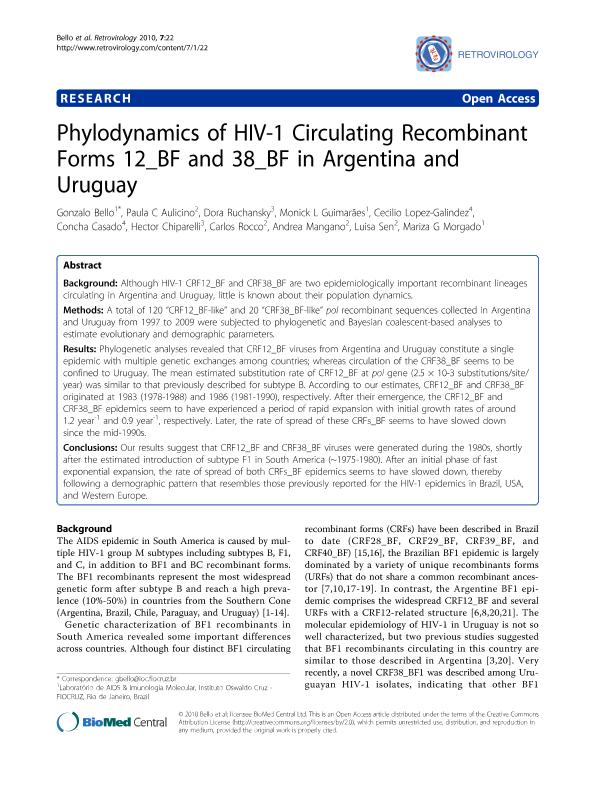Mostrar el registro sencillo del ítem
dc.contributor.author
Bello, Gonzalo
dc.contributor.author
Aulicino, Paula

dc.contributor.author
Ruchansky, Dora
dc.contributor.author
Guimarães, Monick L.
dc.contributor.author
Lopez Galindez, Cecilio
dc.contributor.author
Casado, Concha
dc.contributor.author
Chiparelli, Hector
dc.contributor.author
Rocco, Carlos Alberto

dc.contributor.author
Mangano, Andrea María Mercedes

dc.contributor.author
Sen, Luisa

dc.contributor.author
Morgado, Mariza G.
dc.date.available
2020-03-13T13:05:20Z
dc.date.issued
2010-03
dc.identifier.citation
Bello, Gonzalo; Aulicino, Paula; Ruchansky, Dora; Guimarães, Monick L.; Lopez Galindez, Cecilio; et al.; Phylodynamics of HIV-1 Circulating Recombinant Forms 12_BF and 38_BF in Argentina and Uruguay; BioMed Central; Retrovirology; 7; 3-2010; 22-30
dc.identifier.issn
1742-4690
dc.identifier.uri
http://hdl.handle.net/11336/99433
dc.description.abstract
Background: Although HIV-1 CRF12_BF and CRF38_BF are two epidemiologically important recombinant lineages circulating in Argentina and Uruguay, little is known about their population dynamics.Methods: A total of 120 "CRF12_BF-like" and 20 "CRF38_BF-like" pol recombinant sequences collected in Argentina and Uruguay from 1997 to 2009 were subjected to phylogenetic and Bayesian coalescent-based analyses to estimate evolutionary and demographic parameters.Results: Phylogenetic analyses revealed that CRF12_BF viruses from Argentina and Uruguay constitute a single epidemic with multiple genetic exchanges among countries; whereas circulation of the CRF38_BF seems to be confined to Uruguay. The mean estimated substitution rate of CRF12_BF at pol gene (2.5 × 10-3 substitutions/site/year) was similar to that previously described for subtype B. According to our estimates, CRF12_BF and CRF38_BF originated at 1983 (1978-1988) and 1986 (1981-1990), respectively. After their emergence, the CRF12_BF and CRF38_BF epidemics seem to have experienced a period of rapid expansion with initial growth rates of around 1.2 year-1 and 0.9 year-1, respectively. Later, the rate of spread of these CRFs_BF seems to have slowed down since the mid-1990s.Conclusions: Our results suggest that CRF12_BF and CRF38_BF viruses were generated during the 1980s, shortly after the estimated introduction of subtype F1 in South America (~1975-1980). After an initial phase of fast exponential expansion, the rate of spread of both CRFs_BF epidemics seems to have slowed down, thereby following a demographic pattern that resembles those previously reported for the HIV-1 epidemics in Brazil, USA, and Western Europe.
dc.format
application/pdf
dc.language.iso
eng
dc.publisher
BioMed Central

dc.rights
info:eu-repo/semantics/openAccess
dc.rights.uri
https://creativecommons.org/licenses/by/2.5/ar/
dc.subject
PHYLODYNAMICS
dc.subject
HIV-I
dc.subject
12_BF
dc.subject
38_BF
dc.subject.classification
Enfermedades Infecciosas

dc.subject.classification
Ciencias de la Salud

dc.subject.classification
CIENCIAS MÉDICAS Y DE LA SALUD

dc.title
Phylodynamics of HIV-1 Circulating Recombinant Forms 12_BF and 38_BF in Argentina and Uruguay
dc.type
info:eu-repo/semantics/article
dc.type
info:ar-repo/semantics/artículo
dc.type
info:eu-repo/semantics/publishedVersion
dc.date.updated
2020-03-04T17:33:24Z
dc.journal.volume
7
dc.journal.pagination
22-30
dc.journal.pais
Reino Unido

dc.journal.ciudad
Londres
dc.description.fil
Fil: Bello, Gonzalo. Instituto Oswaldo Cruz; Brasil
dc.description.fil
Fil: Aulicino, Paula. Gobierno de la Ciudad de Buenos Aires. Hospital de Pediatría "Juan P. Garrahan". Laboratorio de Biología Celular y Retrovirus; Argentina. Consejo Nacional de Investigaciones Científicas y Técnicas; Argentina
dc.description.fil
Fil: Ruchansky, Dora. Servicio Nacional de Laboratorios de Salud Publica; Uruguay
dc.description.fil
Fil: Guimarães, Monick L.. Instituto Oswaldo Cruz; Brasil
dc.description.fil
Fil: Lopez Galindez, Cecilio. Instituto de Salud Carlos III; España
dc.description.fil
Fil: Casado, Concha. Instituto de Salud Carlos III; España
dc.description.fil
Fil: Chiparelli, Hector. Servicio Nacional de Laboratorios de Salud Publica; Uruguay
dc.description.fil
Fil: Rocco, Carlos Alberto. Gobierno de la Ciudad de Buenos Aires. Hospital de Pediatría "Juan P. Garrahan". Laboratorio de Biología Celular y Retrovirus; Argentina. Consejo Nacional de Investigaciones Científicas y Técnicas; Argentina
dc.description.fil
Fil: Mangano, Andrea María Mercedes. Gobierno de la Ciudad de Buenos Aires. Hospital de Pediatría "Juan P. Garrahan". Laboratorio de Biología Celular y Retrovirus; Argentina. Consejo Nacional de Investigaciones Científicas y Técnicas; Argentina
dc.description.fil
Fil: Sen, Luisa. Gobierno de la Ciudad de Buenos Aires. Hospital de Pediatría "Juan P. Garrahan". Laboratorio de Biología Celular y Retrovirus; Argentina. Consejo Nacional de Investigaciones Científicas y Técnicas; Argentina
dc.description.fil
Fil: Morgado, Mariza G.. Instituto Oswaldo Cruz; Brasil
dc.journal.title
Retrovirology

dc.relation.alternativeid
info:eu-repo/semantics/altIdentifier/url/https://retrovirology.biomedcentral.com/articles/10.1186/1742-4690-7-22
dc.relation.alternativeid
info:eu-repo/semantics/altIdentifier/doi/http://dx.doi.org/10.1186/1742-4690-7-22
Archivos asociados
